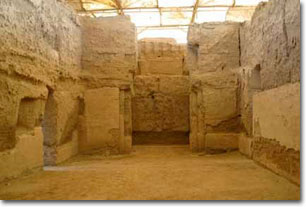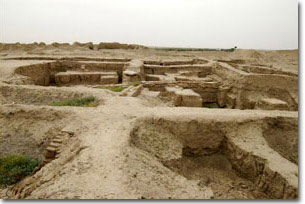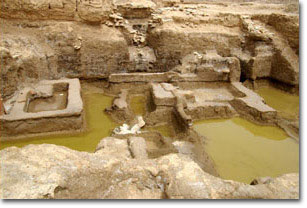|
 140 km
south east of Deir Ezzor, 12 km west-north west of Abu Kemal on
Syria/Iraq border, on the Euphrates; lies a site of a central
importance, Mari, "a unique example of a Bronze Age palace" giving "an
exceptionally concentrated picture of Syro-Mesopotamian world in the
words" of its current excavator, Jean-Claude Margueron. The finds in
Mari have given large contributions to the unraveling of the history of
Syria/Mesopotamia region during the early millennia of recorded
history. Its excavation rested for many years in the hands of the
French archaeologist, Andre Parrot, who supervised the excavations from
1933 to 1974; a remarkable record. Since 1978, excavations have
continued under Margueron with the aim of embracing Mari's role in the
wider Euphrates valley. 140 km
south east of Deir Ezzor, 12 km west-north west of Abu Kemal on
Syria/Iraq border, on the Euphrates; lies a site of a central
importance, Mari, "a unique example of a Bronze Age palace" giving "an
exceptionally concentrated picture of Syro-Mesopotamian world in the
words" of its current excavator, Jean-Claude Margueron. The finds in
Mari have given large contributions to the unraveling of the history of
Syria/Mesopotamia region during the early millennia of recorded
history. Its excavation rested for many years in the hands of the
French archaeologist, Andre Parrot, who supervised the excavations from
1933 to 1974; a remarkable record. Since 1978, excavations have
continued under Margueron with the aim of embracing Mari's role in the
wider Euphrates valley.

Mari was the 3rd millennium BC royal city-state par excellence. It
controlled access between central and southern Mesopotamia and the
drier plains of northern Syria and the upper Euphrates/Khabur system.
Caravan routes through Mari also brought tin for the bronze industries
to the west. Its key position between the confluence of the Khabur and
Euphrates and the cliffs further south at Baghuz explain its choice as
the site for a new city built by political decision. Mari
was first occupied at the beginning of the third millennium (2900 BC).
Positioned in an area of limited natural agricultural potential, the
center based its foundation not only on its trading position but on a
sophisticated irrigation scheme. It was surrounded by a circular
rampart and ditch (1.9 km in diameter) through which was dug a canal
for the dual purpose of water supply and controlling navigation on the
river. The late excavations led to development of canals in Mari,
including a 120 km navigation link between the Khabur and Euphrates
rivers. 
The first major period of development (2700 - 2600 BC) saw the
construction of a great palace, the temple of Ishtar, Nini-Zaza,
Shamash and the terrace area or "Massif Rouge". Mari succumbed to the
Akkadian Empire for a while but re-established its prosperity, its
population heavily boosted by the arrival c2000 BC of many Amorites.
Mari lost out in the power struggle touched off by the rising dynasty
of Babylon. Occupied for a time by the Amorite leader Shamsi-Adad (1813
- 1782 BC), it briefly found its independence under Zimri-Lim (1775 -
60 BC) only to lose it to Hammurabi of Babylon (c1792 - 50) in 1760.
Its walls were razed, its temples sacked and the palace of Zimri-Lim
set on fire and dismantled. The city was no longer a center of any
importance from that time though there are signs of limited
re-occupation in the Seleucid and Parthian periods. The largely mud-brick remains which have been successfully peeled of to
expose the preceding layers beneath are difficult to appreciate. Zimri-Lim palace: It is the most extensive excavated in the Middle East and was
constructed across several centuries. It has 275 rooms covering 2.5 ha.
There is a variety of finds in the palace well preserved including the
notable statues of Ishtup-Ilum (Governor of Mari) and of a water
goddess and an archive of 15000 tablets recording the household
accounts of the palace as well as diplomatic and administrative records
of the kingdom. The main gateway to the palace of Zimri-Lim was on the north eastern
side of the roughly square palace compound which was originally
surrounded by a mud-brick rampart. Many of the rooms were decorated
with wall paintings, partly preserved in the Aleppo and Damascus
Museums as well as in the Louvre. The Religious Buildings: There are also a number of religious buildings around the palace,
including the Temple of Lions (c2000 BC) and that of Shamash. In the
Temple of Ninni-Zaza (mid third millennium BC) was discovered a
remarkably rich trove of statues including that of the singer
Ur-Nanshe. Temple of Ishtar (3rd millennium) is typical of Mari in its layout; they're all very important to inspect. |


